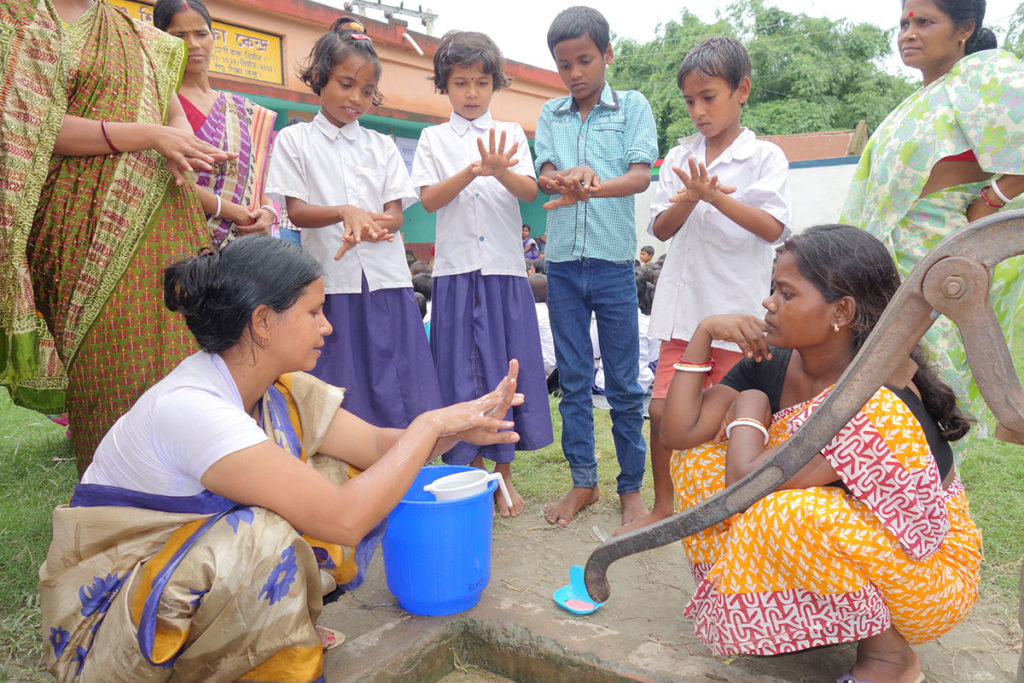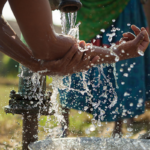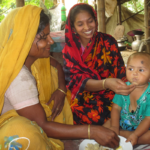Every year, the Global Handwashing Partnership summarizes the year’s peer-reviewed evidence related to handwashing with soap. Our 2017 research summary includes 117 studies and brings together additional evidence for the benefits of handwashing, new information on hygiene behavior change, and some surprising results of handwashing programming.
The summary breaks down what we learned in 2017 into categories like access to handwashing facilities, handwashing compliance, approaches to behavior change and drivers of handwashing behavior. Here, I highlight five studies that stand out to me.
Access to handwashing facilities
The study finds a wide range in access to both proxies between countries, with survey results ranging from less than 1 percent access (in Malawi and Western Kenya) to more than 90 percent (in places like Serbia and Iraq). Disparities appear within regions – for example, Bangladesh had 21.4 percent access compared with 78.7 percent in Bhutan. In nearly every country, wealthier and urban households are more likely to have soap available than less wealthy or rural households. The study, along with the 2017 WHO/UNICEF Joint Monitoring Report, helps us understand the scale of inequities in access to handwashing facilities.
Benefits of handwashing
A mixed methods study in Lofa County, Liberia, from Capps, et al. shows unanticipated long-term effects of water, sanitation and hygiene (WASH) behavior change programming. The study aims to understand Ebola cases reported in communities where the nongovernmental organization Global Communities conducted Community-Led Total Sanitation (CLTS), a community-based approach for eliminating open defecation and improving sanitation and hygiene.
During the 2014–2016 Ebola outbreak in West Africa, no cases of Ebola were found in communities that had engaged in CLTS and were certified as open-defecation-free. One CLTS community that had not reached open-defecation-free status did have cases reported. In focus groups, community members attribute their avoidance of Ebola to WASH behaviors learned from CLTS before the outbreak, especially handwashing with soap and disposal of feces. To me, this study shows how behavior change programming can protect communities in ways that may not be anticipated at the beginning of a project, and how good hygiene protects us against potential outbreaks.
Handwashing compliance
Multiple studies in our annual summary support an important distinction in handwashing behavior change: knowledge does not equal practice. Even when people have a high level of knowledge about the benefits of handwashing, when to wash their hands, and how, we still see low levels of compliance. This is an important reminder that behavior change programs cannot rely on knowledge alone to improve handwashing behavior.
For example, Demssie, et al. survey 251 mothers of children under the age of 5 years in Gotu Kebele, Ethiopia, using a semi-structured questionnaire delivered in person. While more than 99 percent of mothers know the importance of handwashing, their self-reported handwashing practice is much lower. Only 52 percent report washing their hands before feeding their children. Other studies in the summary show similar ‘knowledge-to-practice gaps’ in schools, health facilities and community settings.
Approaches to behavior change
One study by Dreibelbis, et al. featured in our 2016 research summary, looks at the effect of using nudges (simple, often subconscious cues) to increase handwashing behavior in a school in Bangladesh. That small study generated very promising results, with handwashing rates going from 4 percent to 74 percent, but also led to some open questions on how nudges work. I am excited to see more research on this approach in the 2017 literature.
In a study from The Netherlands, Caris, et al. use posters as nudges. The posters are displayed in hospital wards on or next to alcohol-based handrub dispensers. The findings show the poster nudge increases handrub use in one ward at all times and only during doctor’s rounds in another ward. Use of handrub does not increase at dispensers without a nudge, so there remains a need for further research to understand the extent to which nudges may or may not help develop habits even when a nudge is not present. The authors recommend similar poster nudges as an easy, inexpensive way to increase the use of handrub. You can learn more about handwashing nudges in our infographic and FAQ document.
Drivers of handwashing behavior
The RANAS (risk, attitudes, norms, ability and self-regulation) model is a formative research tool to help behavior change researchers understand what motivates people to wash their hands in a specific context. Seimetz, et al. use the RANAS model to understand drivers of handwashing behavior in primary school students in Burundi and Zimbabwe. The authors conduct interviews with more than 600 children in Burundi and over 500 in Zimbabwe; and they use regression analysis to understand the influence of the drivers in the RANAS model to the children’s handwashing behaviors. One of the authors, Dr. Hans-Joachim Mosler, presented details of the methodology in a 2017 webinar.
The authors find some similarity across the two settings. For example, self-efficacy and social norms are effective drivers of handwashing behavior in both the Burundi and Zimbabwe samples. However, the authors find there is a need for a handwashing promotion program to increase the perceived severity of consequences from diarrhea in Zimbabwe, but not in Burundi. They also recommend that a program in Zimbabwe address depression as an underlying factor for lack of handwashing. I am encouraged to see this level of context embraced in formative research for handwashing behavior change. Often, if we look only at factors we assume to be directly related to a target behavior, it’s easy to miss larger health and social issues that form determinants of multiple behaviors.
Looking ahead
Photo caption: At a rural primary school in Malda, West Bengal, India, children learn appropriate techniques of hand washing using soap from NGO volunteers.
Photo credit: © 2015 Birabrata Das/www.rchss.in, Courtesy of Photoshare



